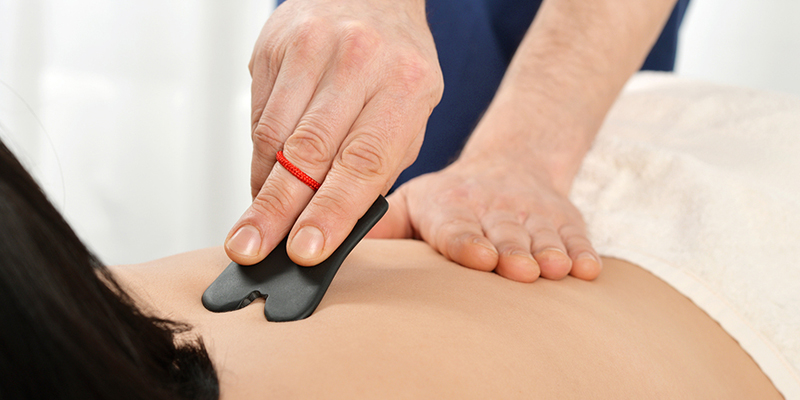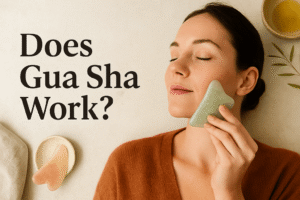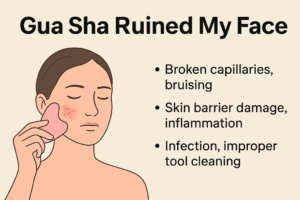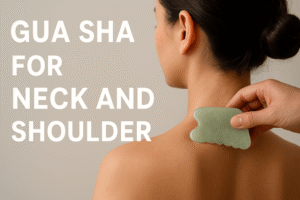
Today, we will reveal the truth behind Gua Sha – Does Gua Sha Really Work
We’ll start a series on the science behind facial devices and beauty techniques. Today, we will be talking about the first in our series – Gua Sha. We’ve all heard of jade rollers, but what is Gua Sha and what are its benefits?
What is Gua Sha?
Traditionally, Gua Sha is the practice of using tools to apply pressure and scrape the skin to relieve pain and tension and increase blood circulation in the area. It is popular for pain relief in the context of practitioners of Eastern medicine, but over the past few years, we have also seen Gua sha enter the beauty world. In the beauty world, facial scraping involves the use of boomerang-shaped or curved tools, usually made of jade or rose quartz. These are said to reduce puffiness, boost circulation, release muscle tension and increase the absorption of cosmeceuticals. Before we dive into whether this beauty tool actually works, let’s learn more about where this technique comes from.
The History of Gua Sha
Gua Sha is a traditional East Asian healing technique. The technique is divided into two parts: “scratch” for scraping and “sand” for redness. Other names for gua sha include casting, scraping, or scooping. Dating back to ancient China, scraping first appeared in a classical Chinese medical work called Treatise on Febrile Diseases, dating back to 220 AD. According to Chinese medicine, qi is the energy that flows through the body. The ancients believed that one’s qi must flow and balance. To maintain good overall health and well-being. People who used to scrape in those days believed that qi deficiency was the root cause of inflammation, which would lead to chronic pain. Therefore, rubbing or scraping the surface of the skin to obtain “sha” is believed to help the chi flow again. This helps reduce inflammation and promote healing.
Gua Sha Facial Effect
Some product claims for the Gua Sha skincare kit include its use as part of a moisturizing skincare routine. It is claimed to increase the absorption of skincare products and correspondingly increase the skincare benefits of active ingredients. These scraping tools also claim to stimulate skin cell renewal and improve lymphatic drainage by increasing blood flow.
We are honored to invite Dr. Deng, a dermatologist with more than 20 years of experience in the industry, to answer the truth behind Gua Sha – does it really work?
Will Gua Sha leave bruises? What are the benefits of facial Gua Sha for the skin?
Dr. Deng: Since scraping does improve microcirculation, when scraping is used as a facial massage tool, it is certain that the transport of active ingredients absorbed through the skin will be improved. However, depending on the amount of force, bruising may occur. These precise breaks in blood vessels are certainly not desirable. Additionally, this can lead to hyperpigmentation of the face in some people who are prone to hyperpigmentation. The blood contains hemosiderin, which can cause brownish-black deposits on the skin. Mechanical trauma may also lead to post-inflammatory hyperpigmentation.
In science, keeping an open mind is very important. In my opinion, further research is definitely needed to see if these unknown mechanisms might benefit facial skin. And in the use of scraping the face as an anti-aging tool.
Are There Any Studies Discussing the Effects of Gua Gua on The Skin?
Dr. Deng: There have been studies on the effects of gua sha and treatment on the microcirculation of superficial tissues. This was published in Journal Explorer in 2007 by Nielsen et al. Although it is relatively old, it still has a certain reference value.
Essentially, laser Doppler images measure skin circulation, especially microcirculation before and after Gua Sha treatment. This was done at the German Department of Nephrology, which is dedicated to kidney research, on just 11 subjects. The result was that Gua Sha increased the microcirculatory perfusion units by a factor of 4 in this specific treatment area during the first 7 minutes and 1/2 minute. There was a statistically significant increase in post-treatment circulation throughout the 25-minute study period. There was also a reduction in myalgia — a feeling of muscle pain, pain, and soreness. This obviously applies to areas other than Gua Sha as well.
Can You Tell Us More About how Gua Sha can Benefit the Skin?
Dr. Deng: For facial gua sha, it seems to be more and more popular. Physiologically, however, the benefits of scraping are currently unknown. The skin or skin changes caused by Gua Sha are known to cause bruising and petechiae, which are precise bleeding under the skin. When you translate the concept to apply to the face, it is similar to a facial massage. However, you should put less pressure on the body than with traditional gua sha. The data we have now seem to suggest that the physiological changes that occur are primarily related to improved microcirculation. In theory, this means it can have the same function as a jade roller or any other massage tool. Helps increase the absorption of substances applied topically to the skin.
Gua Sha Work Faqs
- Can I Use Gua Sha Every Day?
Gua Sha is acceptable for the face, but not for the body. Whether you can perform Gua Sha daily depends on the severity of the damage it causes you. It will inevitably cause some adverse reactions on the surface of the skin, but the degree of severity varies.
- Should Tools be Disinfected Before Gua Sha?
Yes, please clean your tools before gua sha. For materials like crystal and jade, we recommend using alcohol for disinfection. Avoid high-temperature disinfection to avoid damaging the tools.







